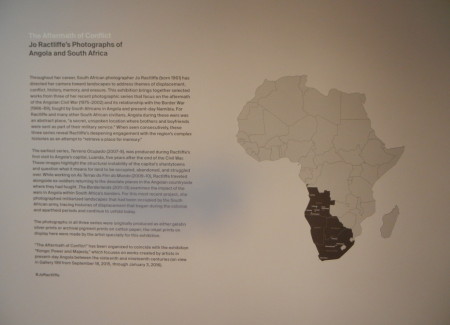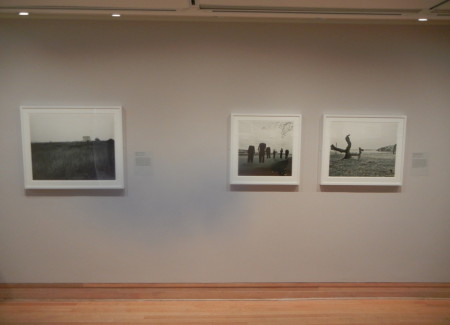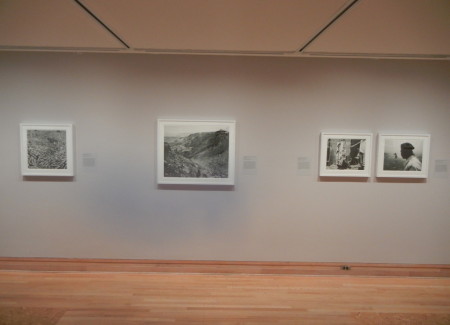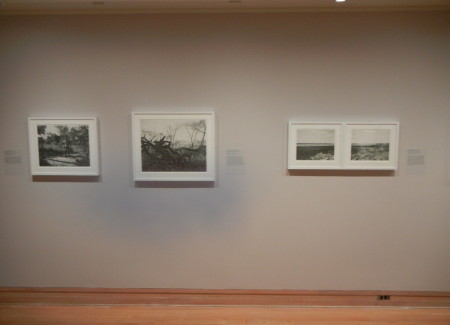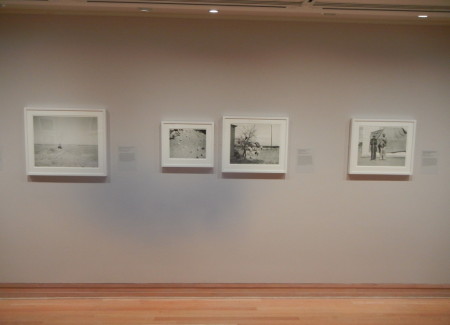JTF (just the facts): A total of 29 black and white photographs (as 23 works), framed in white and matted, and hung against grey walls in a single room gallery space on the mezzanine floor of the museum. All of the works are inkjet prints, made between 2007 and 2014. No size or edition information was provided.
The show includes works from three separate projects:
- Terreno Occupado: 12 inkjet prints (10 single images and 1 diptych), 2007-2008
- As Terras do Fim do Mundo: 8 inkjet prints (3 single images, 1 diptych, 1 triptych)2009-2010
- The Borderlands: 9 inkjet prints (6 single images, 1 triptych), 2011-2013
(Puzzlingly smudged installation shots below.)
Comments/Context: South African photographer Jo Ractliffe has spent the better part of the past decade probing the complex history of the Angolan civil war (1975-2002) and the Border War (1966-1989) that took place along the dividing line between South Africa and Angola/Namibia, and documenting their combined effects on the lands in which they took place. While others might have spent hours delving back into archives, Ractliffe took to the road, rediscovering the physical remnants of old battlegrounds, military posts, graveyards, and abandoned sites of one time importance now settling back into the dust and weeds of the scrubby terrain. Her projects are journeys that balance visual absence and stubborn presence, where fragments and memories of her country’s conflicted past lurk in plain sight, continuing to quietly influence the present.
Terreno Ocupado looks at the area around Luanda in the aftermath of the Angolan civil war and pinpoints the unceasing competition for resources still taking place there. A bold hand painted sign with those words (“occupied land”) amid an otherwise grassy wasteland is a reminder that even the most humble and unassuming locations are still contentious. Portuguese colonial remnants can be found repeatedly – in tiled murals that seek to legitimize their presence and in the grandiose interior of the Banco Nacional de Azora with its marble columns and opulent décor. This deliberate show of wealth seems particularly ostentatious and pretentious when juxtaposed with the hellish landscapes of shanty towns surrounded by towering hills of falling garbage and markets engulfed in choking smoke. Rotting hulks of capsized vessels on the deserted beach and eerie silhouetted worker’s overalls hanging from the trees like corpses point to additional interests and claims. And Ractliffe’s image of a woman watching TV shows in a market video booth tells the story symbolically – everything important seems to have happened behind the curtain.
In As Terras do Fim do Mundo (previously reviewed here), Ractliffe heads out into the Angolan countryside in search of the actual fighting locations. She finds faded remnants of Soviet and Cuban influence, in the form of painted murals of Che and Brezhnev and stony deserts previously host to the bunkers, trenches, and anti-aircraft weaponry of a military base. For the most part, these pictures are indirect, documenting the now hidden and disappeared, with dangerous landmines still waiting amid scrubby lands and corn fields and an unassuming muddy riverbank the site of a now historic battle. Even in their delicate tonalities, these images feel full of pregnant tension and danger, the largely invisible still providing a powerful pull.
In The Borderlands, Ractliffe turns her attention to the once militarized lands near the South African border, capturing in particular the dismal reality of the relocation and displacement of South African veterans. Like her other series, the stage is set with absence – a decommissioned military post stands empty in the dust and punishing sun, while an abandoned asbestos mine (with a “God with us” graffiti tag) is locked up, both ghostly remnants of what was. Forgotten veterans waste away in derelict buildings, with their laundry hanging on trees and playing simple games in the dirt; the template for digging graves stands ominously nearby, with rows of rectangles covered in broken concrete in the distance. A ceremonial skin pelt or an upright stance (aided now by a cane) is the only reminder of their proud service; conflict and apartheid seem to have combined to create a particularly unworthy outcome for their efforts.
All three of these well-crafted projects turn on the erasures of time, digging into the scars of history and their lasting resonance. Ractliffe’s landscapes aren’t about the beauty of nature itself (although many of her prints are remarkably refined and elegant), but about the land as a territory permanently infused with the struggles of humanity – even in its most desolate form, those places have subtle stories to tell that echo through to the present with surprising power and force. Her pictures offer no answers, only stark evidence; like the work of fellow South African David Goldblatt, they hold a mirror up to society, ensuring we feel the weight of those traumas and sacrifices and take into account how those actions continue to influence the creation of the national future. She seems to say that the land itself is full of elusive connections and incisive answers, if we only bother to look closely.
Collector’s POV: Since this is a museum show, there are of course no posted prices. Jo Ractliffe is represented by Stevenson Gallery in Cape Town and Johannesburg (here). Ractliffe’s work has not yet reached the secondary markets with any regularity, so gallery retail likely remains the best option for those collectors interested in following up.
